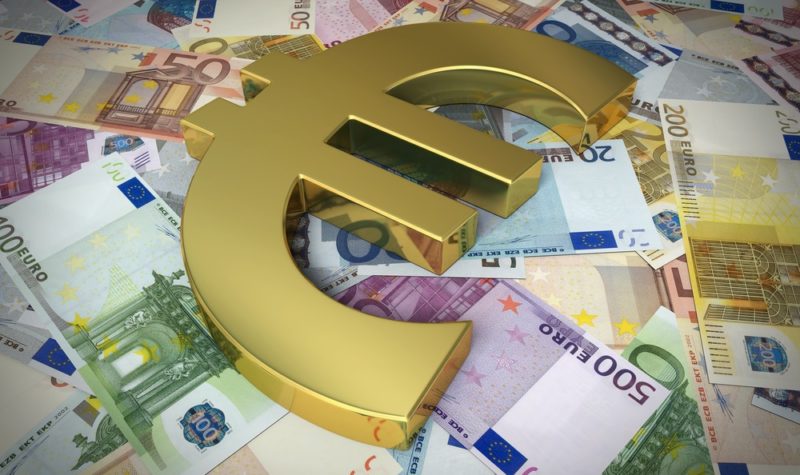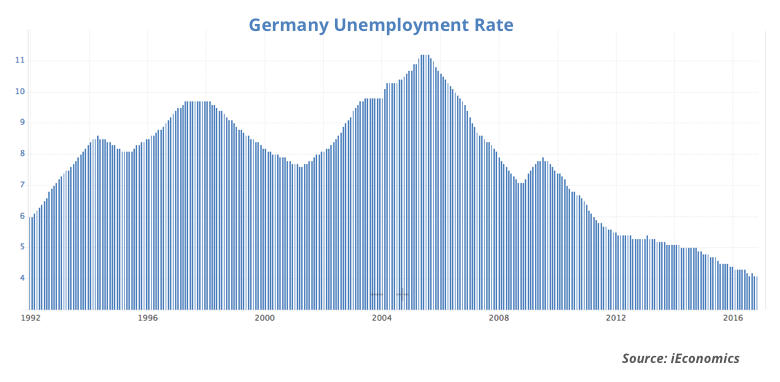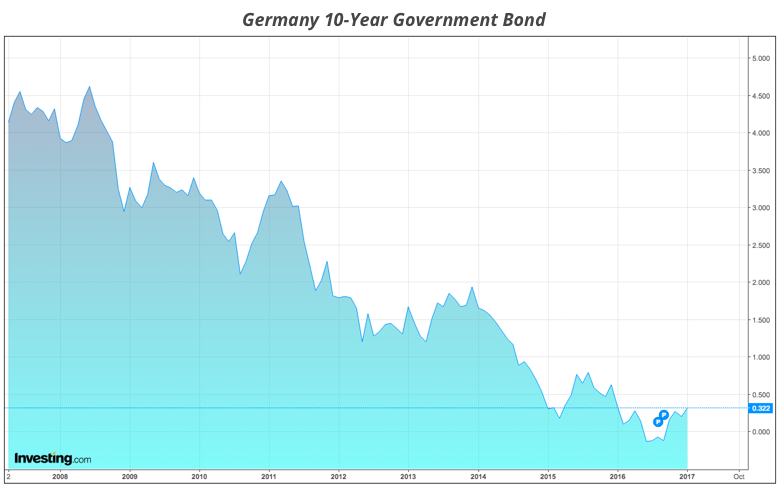German economic bounce to lift the euro

We are at an important juncture in Europe. In particular, in the eurozone. For the last few years this group of countries has been performing badly both in economic and political terms.
Poor decisions combined with a lack of economic and political integration and unfortunate external interference (through terrorism and political manipulation) have led the eurozone into the worst of times, both in terms of economic performance and in terms of social and political cohesion.
But, while 2017 will be a challenging year – Germany, France and the Netherlands are going into important elections where radical anti-EU groups are rising in influence – it may end with a brighter outlook than many are currently predicting.
While the economic recovery has been sluggish, the most recent economic indicators are relatively upbeat, with Germany approaching full employment and recording an inflation rate that is very close to the ECB’s medium to long-term goal of 2%. At the same time however, the yield on the 10-year Bund is 0.32%, reflecting a massive bubble in bond prices due to the ECB asset purchase programme.
Despite the central bank’s best efforts to revive the European economy by setting key rates at or below zero and by purchasing public and private assets, the eurozone has been living in a dormant state which has led to the rise of radical political parties that have been pushing for economic disintegration as the shortest way of returning to economic prosperity.
Brussels’ impositions on indebted countries, a lack of economic and political integration, a poorly designed banking system, the lack of a fiscal stabilisation mechanism: all are part of the explanation for the current state of the eurozone (in particular) and the broader European Union (in general). Add the rise in terrorism to the equation and you end up with a rise in populism that historically has driven Europe to the worst of outcomes.
But, while the descent has been huge and pessimism is pervasive, I believe 2017 may prove to be a better year than most would hope for. Recent economic data has been positive and will likely lead to a retreat in European populism, on the back of a faster than expected GDP growth and a rise in the euro.
A few days ago, data released for the German economy showed GDP growth of 1.9% in 2016, coming in on top of an unemployment rate of 4.1% and a public budget surplus of €6.2 billion. While certainly not a stunning growth rate, 1.9% was great enough to surpass government projections.
Economists still predict a much more moderate growth rate of 1.3% in 2017, but given the excess of pessimism that overlays almost all EU predictions, and after weighing the potential spill over effects from German growth to the EU economy, I believe growth may come closer to last year’s figure. Germans have a tradition of finding their way out of sluggish performance and I believe that the negative impact stemming from Brexit and Trump will prove less of an issue than currently thought.
But, while the German economy is flying high, German bond yields are flying low. The latest numbers regarding inflation point to a figure of 1.7%, which has been a huge surprise. The 0.32% yielding 10-year German bond seems completely unsynchronised with that figure, which makes it an epic short.
Not only will a rise in inflation in Germany have a direct negative impact on bond prices; it will also weigh on future ECB policy decisions. Germany is a heavyweight in ECB policymaking and I doubt Draghi will find support to further ease policy given the most recent data coming from Germany.
German bond prices are disconnected from fundamentals. Prices are high because of the ECB €80 billion/month asset purchase programme, which is bidding up the price of the ever more scarce German bonds. With the German government now on its third straight budget surplus, the ECB must rely solely on the existing stock of bonds, which is driving prices higher (or at least well above what they would be if there was no central bank demand).
…I doubt Draghi will find support to further ease policy given the most recent data coming from Germany.
Speculators who are still ignoring the fundamentals and buying German debt in the hope there will be another fool buying from them (the central bank), and investors relying on bonds as a long-term investment, should rethink their strategy by now. With the German economy showing an employment at its highest since the German reunification in 1990 while inflation runs at 1.7%, investors should ask themselves the question:
How much margin remains for the ECB to pursue more monetary easing, or even to keep its current programme at these levels until the end of 2017?
We are definitely at the lowest point for interest rates. Inflation is already picking up in Germany and will follow in other eurozone countries. If there’s any surprise to come in the year, it will be in the form of a tapering of the current asset purchase programme. This leads me to bet against European bonds in general, and German bonds in particular.
Those relying on bonds should opt for shorter maturities for now, as these are expected to suffer much less. The worst decision an investor can make at this point is to buy into the new trend that is leading some European governments to issue long-dated bonds. At a time of near-zero yields, these long-dated bonds have superficial appeal but they are loaded with huge risks, as they would experience massive price depreciation were interest rates to start rising. Unless you believe that rock bottom interest rates will last for the next 50 years, then avoid them at all costs.
Apart from shorting bonds – and this is something that comes as a natural consequence of the arguments made above – I am bullish on the euro. While the eurozone has been through tough times, it is likely that the worst is already behind in economic terms.
The Eurozone has been able to return to a one-digit unemployment rate in 2016 and employment is recovering in every member state. The peripheral countries of Spain, Greece, Italy and Portugal are currently performing much better than in 2012-2014. Unlike Germany, where unemployment seems already at its long-term trend, in these peripheral countries there is still a mountain to climb. Nevertheless, they are now in a much better financial position and less prone to austerity policies.
I’m increasing my long exposure in the EUR/USD because I believe the European economy will grow faster and I’m becoming a lot more sceptical about the US economy, in particular after Trump’s speech. He seems to lack a proper strategy and may create some uncertainty in the country.


Comments (0)